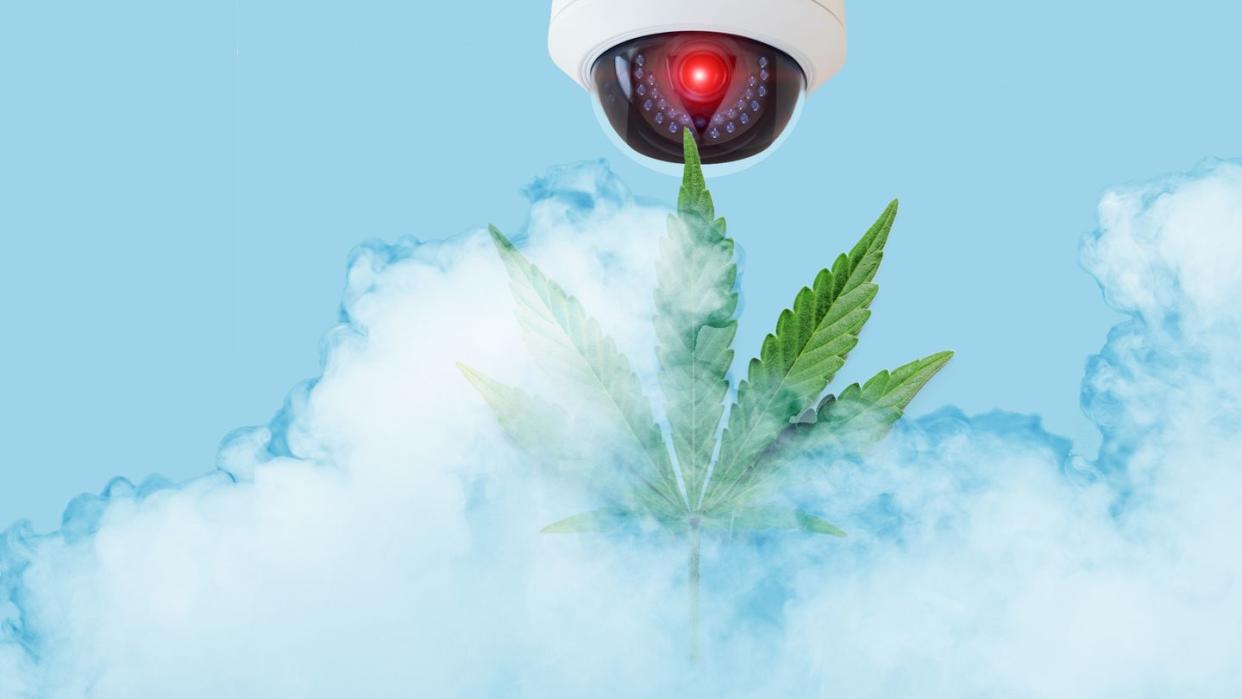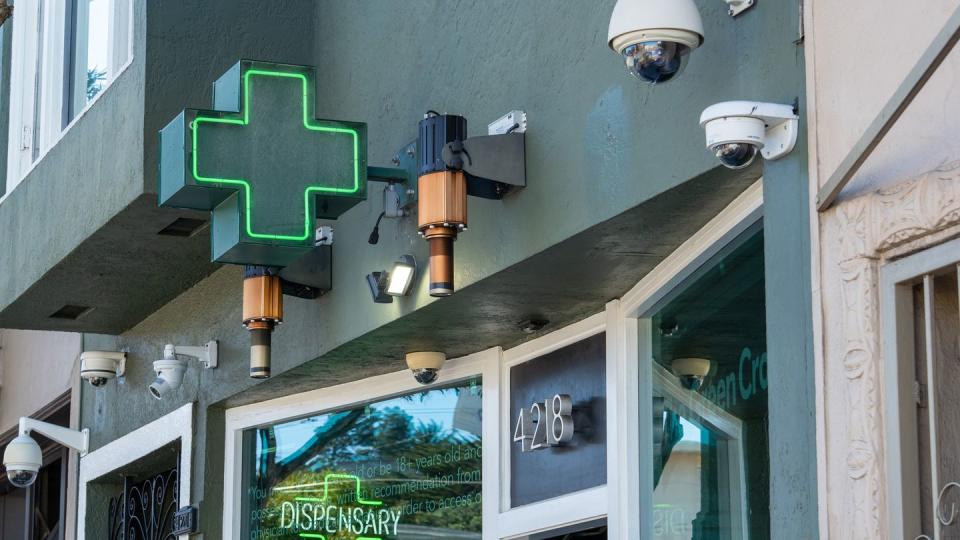How Weed Dispensaries Protect Their Stash. And Their Cash. And Their Customers.

"Hearst Magazines and Yahoo may earn commission or revenue on some items through these links."
Just for a moment, let’s say you were of the mind to rob a store. An old-fashioned stick-up, perhaps. Maybe a smash-n-grab. Even before you start shopping for silencers, duffle bags, and a fake mustache, you’d naturally scope out the perfect target: a shop loaded with extremely valuable merchandise (that’s easily tossed in the duffle bags) or one fat with cash (that’s easily tossed in the duffle bags). Of course, the ideal would be a shop featuring both—which is exactly what makes your humble neighborhood cannabis dispensary such an extraordinary mark.
Much of this is due to the fact that, under federal law, cannabis remains illegal, and credit card companies aren’t willing to risk the fed’s wrath by touching marijuana money. This forces dispensaries to do the lion’s share of their business in cash. Meanwhile, filched flower can be conveniently resold on the black market in nearby dry counties or states. How much cash and cannabis do dispensaries keep on hand? That depends on location, foot traffic, whether Phish is in town, store size, time of year, etc., but for larger shops, some industry experts told me the amount of cash could easily sit between $100,000 and $200,000, plus that much in product as well. In other words, hardly an Ocean’s Eleven haul but not a bad day’s work, either. Of course, for a small, mom-and-pop dispensary, a loss like that could be a deathblow.
Weed-store robbery numbers aren’t easy to come by—“the cops could give a shit,” one store-owner told me—but Adán Espino, former executive director of the Craft Cannabis Coalition, shared some self-reported statistics gathered by dispensaries in Washington state indicating that in 2022, there were 102 armed robberies and burglaries. If you’re mathing at home, that’s one every 3.6 days.
Given the high stakes, how, exactly, do dispensaries keep their cash, merch, customers, and staffers safe?
It ain’t easy. For starters, state or city ordinances often determine where shops can and can’t be located, which sometimes relegates a store to sketchy-ass neighborhoods or spots that turn ghost-town at night. Likewise, some states explicitly prevent dispensary owners from keeping weapons on the premises, which, of course, the bad guys are likely wise to. (And if they weren’t before, they are now.)

While every dispensary must adhere to a mountain of state-ordained security regulations (Massachusetts, for instance, requires that products can’t be viewed from the street “without the use of binoculars, optical aids or aircraft”), it’s mostly up to individual owners to determine how overt or subtle a part of the customer experience such measures become. I’ve walked into dispensaries with San Quentin levels of security (barred windows, beefy cameras, plexiglass barriers, buzz-you-in-buzz-you-out anterooms), and I’ve also seen my share of airy, spa-like boutiques with polished wood, pink orchids, cute-as-a-button budtenders named Kelani and DJ, and not a camera in sight.
But make no mistake: All dispensaries are required to be camera-ed up, so just because you can’t spot the video surveillance doesn’t mean you’re not on candid cannabis camera. In fact, every spot in the store where a cannabis transaction occurs (counters, registers) and where the product is touched (like in the backroom) must be filmed from multiple angles.
With 186 stores in 11 states, Trulieve is one of the largest multistate operators in the country, and Nilyum Jhala, its chief technology officer, oversees, among other things, all the technical aspects of dispensary security. Trulieve has cameras monitoring all transaction points, as well as entrances and exits, the parking lot, and the back of the store, not to mention its delivery trucks, which are outfitted with both cameras and a GPS tracker. “Between 30 and 40 people actively monitor the camera systems 24/7,” Jhala told me. Beyond that, he says, “there is artificial intelligence that might, for instance, pick up if a particular lobby is getting a little too crowded.” Panic buttons direct-dial both security and law enforcement. (Staffers arriving early or leaving late can call the Trulieve security center to ask if the coast is clear outside the shop and can be in contact with the center as they walk to their car.)
Steve Weiner, who owns Bighorn Weed Company, a super-popular independent dispensary in Taos, New Mexico, knows something about security: For six years, he served as an officer on nuclear submarines in the U.S. Navy, including a stint on a Seawolf fast-attack sub in the Arctic. “I had top-secret security clearance and access to sensitive information,” he told me. “And that experience informs how I’ve approached this business.” I found that intriguing because Bighorn is the most laidback, low-key weed establishment I’ve ever set foot in: Exactly zero products sit behind glass, the counter itself is small and doesn’t create a barrier to the staff or to the back room, the cameras are hard to spot. Oh, and there’s an upright piano that looks like it was dragged straight from a saloon.
Weiner’s approach to security is holistic, psychological, and strategic: “Even though it has a very high dollar-value per square inch, we’re intentionally not signaling that this is like a jewelry store,” he says. “It's really no different than if you walked into a nice wine shop in Sonoma County. You wouldn't see bottles behind glass.” Part of his strategy also relies on Navy-style compartmentalization: Only a fraction of his flower, pre-rolls, and edibles is kept in the front of the store; the rest is accessed by way of increasingly secure rooms that employees need a unique punch code to access. (Weiner says employees, if not hired carefully, can represent “a threat vector from inside the organization. You know, they brag to their friends about all the cash.”) Only Weiner has access to the inner-most sanctum.
There is, of course, another way into a dispensary’s inner-most sanctum: ram your car straight through its wall, something the folks at Deep Sentinel, a Pleasantville, California-based security company, have seen more often than you’d think. That said, most break-ins, they tell me, happen the old-fashioned way: with a crowbar to the front or back door. To thwart this, when Deep Sentinel’s AI-assisted cameras pick up a suspicious character, it takes less than 20 seconds for a guard in an off-site control room to assess the situation, hit the siren and, through a speaker, tell the no-goodniks to bugger off. But the company is working on another line of defense, still in beta and expected to launch later this summer: an in-store, drop-from-the-ceiling “smoke deterrent,” essentially a smoke bomb that, when triggered by an off-site guard, makes it near impossible to see, and even harder to toss jars of Crunch Berry Kush into a duffle bag. With dispensaries now outpacing almost all of Deep Sentinel’s commercial categories—even auto dealerships—the future definitely looks smoky.
Obviously, the fat stacks of cash on hand is what’s inspiring the car-ramming and stick-ups, which is why the cannabis community has been pushing Congress to pass the SAFE Banking Act, which could allow dispensary customers to, yes, use their credit card to purchase weed. Some dispensaries allow the use of Dutchie Pay or CanPay, cannabis-specific cashless payment apps; some take debit cards, typically with a $3 fee. But as long as cash is still king, crowbars will be prying at the palace doors.
You Might Also Like

